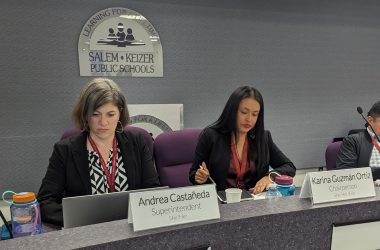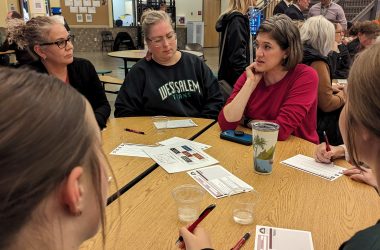 Students eat breakfast on the first day of school at Bush Elementary School. (Rachel Alexander/Salem Reporter)
Students eat breakfast on the first day of school at Bush Elementary School. (Rachel Alexander/Salem Reporter)
The use of millions of state dollars to improve local schools rests in the hands of about three dozen Salem-Keizer community members and local educators.
Salem-Keizer leaders have until March to tell the state how they will spend about $35 million, the district’s expected portion of a $2 billion education package the Oregon Legislature approved in the spring.
The state is awarding about half of the money to school districts to better meet students’ behavioral and social needs and reduce disparities in academic performance.
Additional money is aimed at preschool and early learning programs.
READ: With one hire, Oregon starts down road of spending $1 billion on schools
[ Help build Salem Reporter and local news – SUBSCRIBE ]
Those academic disparities are significant in Salem-Keizer and haven’t improved in the five years students have faced the same test for English and math.
Districtwide, about half of students passed the state reading test last year. Only one in three black and or Native American students hit the mark. For students with disabilities, fewer than one in five met the state benchmark.
Similar gaps exist in math performance and graduation rates, though the number of students graduating in Salem schools has been improving.
(Graphic by Rachel Alexander/Salem Reporter)
Superintendent Christy Perry convened a task force in September to consider students who lag behind district averages. She focused the group on black, Pacific Islander and Native American students, students from low-income families, students with disabilities and those who are homeless or in foster care.
“Our goal is solid recommendations even if it takes a little more time,” she told the Salem-Keizer School Board Tuesday.
That group is meeting weekly through October and will oversee seeking community ideas about how the extra money should be spent, starting in the next school year.
Citizen volunteers Adriana Miranda and Reginald Richardson lead the group.
Miranda is a Salem-Keizer parent and chief of staff for state Rep. Diego Hernandez. She previously co-chaired a task force on school attendance boundaries.
Richardson is executive director of the Oregon Alcohol and Drug Policy Commission and vice president of the Salem-Keizer NAACP.
The group also includes two Salem-Keizer high school students, leaders from the district’s two employee unions and representatives from local businesses, child welfare agencies, the Salem Leadership Foundation and the Salem-Keizer Coalition for Equality.
Twenty-two members are Salem-Keizer employees, including principals and administrators, teachers, counselors and community outreach workers from schools across the district.
(Graphic by Rachel Alexander/Salem Reporter)
State guidelines provide four areas where money can be spent. Districts can add classroom time by lengthening the school day, school year or supporting before and after school programs.
Districts can reduce class size by hiring more teachers or classroom aides, address health and safety concerns by hiring more behavioral staff, school counselors or making improving building safety.
They can also use money for creating a “well-rounded education,” a broad category that includes more help with reading in early elementary school or more classes like art, music, PE, science and technology.
Perry said any effort to add more electives, especially in elementary school, would likely require lengthening the school day.
Elementary schools prioritize reading and math instruction. Science and social studies, which are core subjects in middle and high school, often get only a short lesson a few times a week for the district’s youngest students.
“We don’t have enough time,” Perry said. “Really we should have more science too.”
Recommendations are still months out, and any plan will go before the school board for public comment and a vote before district leaders send it to the state.
“It is the right time for people to start paying attention to it,” she said.
Citizens with questions or feedback can submit them directly to a school board member or to [email protected].
The task force has scheduled meetings for Mondays – Oct. 14, 21 and 28 – from 5:30-7:30 p.m. at the Willamette Educational Service District.
Reporter Rachel Alexander: [email protected] or 503-575-1241.

Rachel Alexander is Salem Reporter’s managing editor. She joined Salem Reporter when it was founded in 2018 and covers city news, education, nonprofits and a little bit of everything else. She’s been a journalist in Oregon and Washington for a decade. Outside of work, she’s a skater and board member with Salem’s Cherry City Roller Derby and can often be found with her nose buried in a book.









